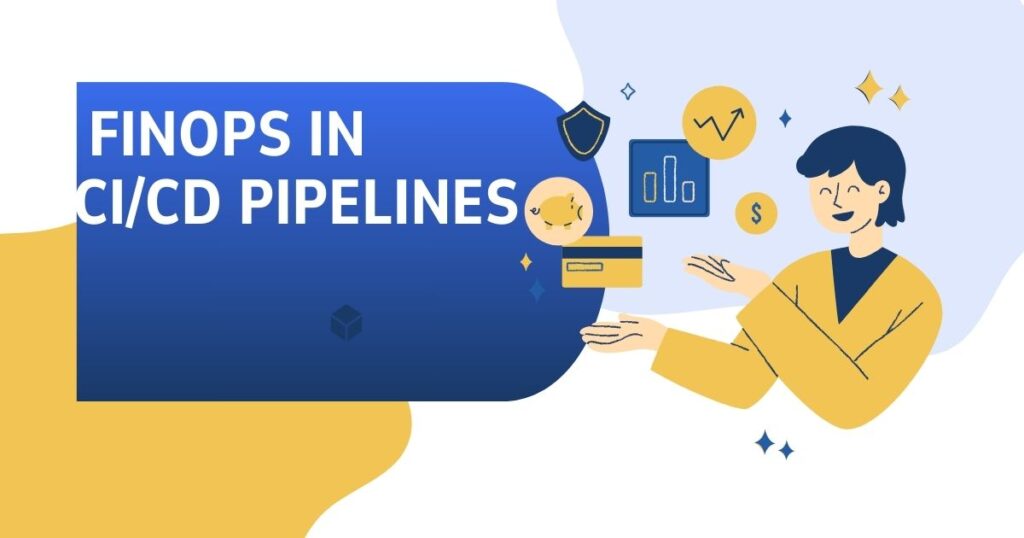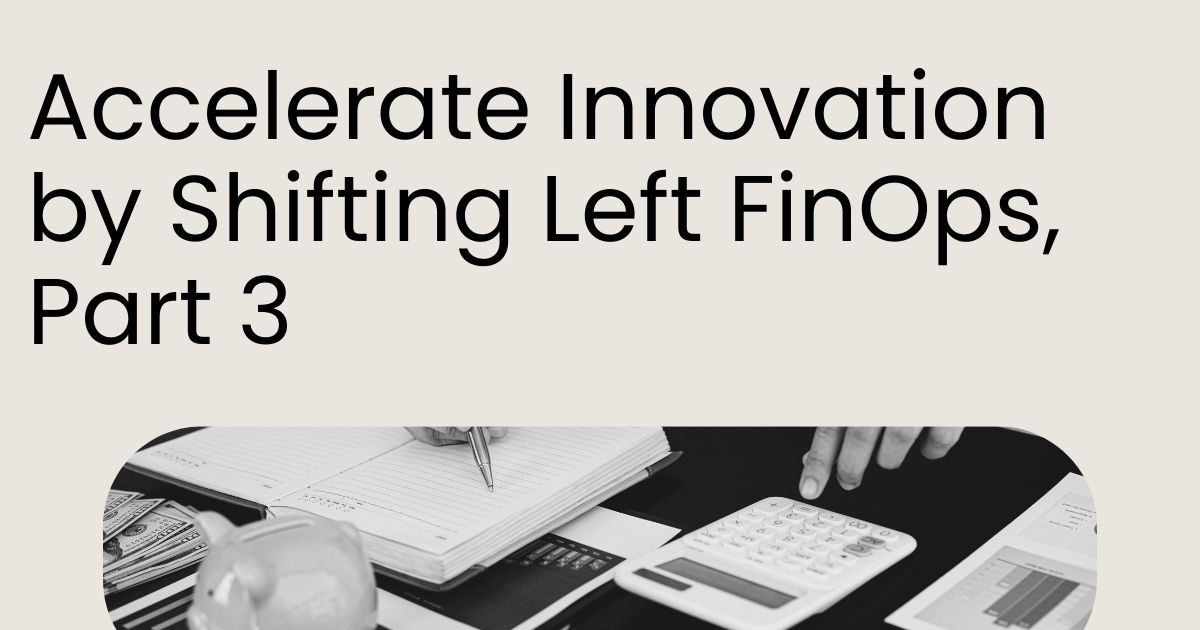In today’s rapidly evolving cloud ecosystem, businesses must prioritize financial operations (FinOps) to control cloud spending while driving innovation. One of the most effective strategies to achieve this balance is Shifting Left FinOps, where financial oversight is integrated early in the development lifecycle. This proactive approach ensures proactive cost visibility and enhances cloud spending efficiency by aligning financial decisions with innovation goals from the outset.
In this article, we explore how Shifting Left FinOps can accelerate innovation by optimizing cloud cost management, fostering cross-functional collaboration, and leveraging automation for long-term financial agility.
Understanding Accelerate Innovation by Shifting Left FinOps, Part 3
Shifting Left FinOps refers to incorporating financial considerations early in the development and decision-making process. Traditionally, financial operations were handled after a project had already incurred significant costs, often leading to inefficiencies. Shifting FinOps left in the development cycle allows teams to monitor costs, set financial KPIs aligned with innovation goals, and make adjustments proactively, rather than reactively.
In cloud environments, where expenses can quickly escalate if left unchecked, optimizing cloud cost management through a Shift Left FinOps strategy is essential to maintaining control over cloud resource usage while supporting innovation.
Also Read: Reworder: A Comprehensive Guide to Enhancing Your Writing
The Benefits of Accelerate Innovation by Shifting Left FinOps, Part 3
Adopting a Shift Left FinOps approach offers numerous benefits, particularly in optimizing cloud operations, enhancing financial transparency, and improving collaboration across departments. Here are the key advantages:
1. Financial Agility and Real-Time Decision-Making
By integrating FinOps from the start, teams gain proactive cost visibility and can react swiftly to financial changes as they occur. Real-time access to cloud spending data allows for immediate adjustments, ensuring that cloud spending aligns with innovation needs. This agility not only ensures cloud cost control but also allows teams to innovate faster.
“Shifting FinOps left in our workflow allowed us to spot and rectify inefficiencies early, giving us a major advantage in terms of both cost and innovation speed.” – Jennifer Liu, VP of Cloud Operations at BrightCloud.
2. Proactive Cloud Cost Management
Proactively managing cloud costs is a key element of the Shifting Left FinOps approach. Instead of waiting until the end of a project to assess costs, teams can monitor and adjust spending as the project progresses. This helps reduce cloud waste, prevent overspending, and ensure that every cloud dollar is aligned with business goals.
Effective cloud cost control means having the right monitoring tools in place to provide continuous visibility into cloud resource usage.
3. Cross-Functional Collaboration
Cross-functional collaboration is crucial for FinOps success. By encouraging communication and collaboration between finance, engineering, and operations teams, Shifting Left FinOps ensures all departments are aligned on cost-saving objectives and innovation acceleration.
Teams that collaborate early on financial KPIs and resource allocation make more informed decisions, resulting in optimized cloud spending efficiency. This synergy also enhances the overall decision-making process, leading to better resource management and faster innovation.
4. Enhanced Cloud Spending Efficiency
A critical benefit of Shifting Left FinOps is improved cloud spending efficiency. Teams can avoid over-provisioning and optimize cloud resource usage when financial oversight is embedded early in the process. This ensures that cloud resources are allocated efficiently, avoiding unnecessary expenses while maintaining performance.
When teams integrate financial and operational decisions, they can optimize resource usage and maintain a balance between cost and innovation.
Key Strategies for Accelerate Innovation by Shifting Left FinOps, Part 3
Implementing Shifting Left FinOps requires a well-defined set of strategies. These steps will help you embed FinOps into your development lifecycle and ensure cloud cost management is optimized from the start:
Embed FinOps in CI/CD Pipelines

Integrating FinOps into Continuous Integration/Continuous Deployment (CI/CD) pipelines enables financial visibility throughout the software development process. By monitoring costs in real-time during each stage of development, teams can make informed decisions early, avoid unnecessary expenses, and ensure alignment with both financial and innovation goals.
Embedding FinOps into CI/CD processes also makes it easier to set financial benchmarks, monitor costs in real-time, and adjust cloud resources as needed, all while fostering innovation.
Automate Cost Tracking and Reporting
Automating cost tracking is a cornerstone of successful FinOps management. By leveraging cost automation tools, such as AWS Cost Explorer or CloudHealth, teams can monitor cloud usage and spending in real-time, providing immediate insight into potential cost-saving opportunities. Automation reduces the risk of human error, making financial tracking more accurate and reliable.
With automated reporting, organizations can track key metrics, such as cloud spending efficiency and financial KPIs aligned with innovation goals, without manually compiling data. This automation not only streamlines financial operations but also supports proactive resource optimization.
Define Clear Financial KPIs Aligned with Innovation Goals
Setting clear financial KPIs aligned with innovation goals ensures that teams can track their progress and make data-driven decisions. KPIs should focus on the balance between cloud resource utilization and the speed of innovation. Examples include metrics like cost per innovation or resource utilization efficiency.
Having defined financial KPIs allows teams to assess whether their cloud spending is translating into meaningful innovation, thereby ensuring long-term business growth.
Educate and Empower Teams on FinOps Best Practices
For Shifting Left FinOps to succeed, it’s important to educate and empower all teams involved. Finance, engineering, and operations teams need to understand the principles of early cost management, as well as how their actions impact cloud spending and innovation outcomes.
Training and onboarding programs that focus on FinOps best practices can help build a culture of financial accountability. Empowered teams are more likely to actively participate in cost-saving initiatives and collaborate effectively on financial decisions.
Foster Collaboration Between Finance, Engineering, and Operations
The success of Shifting Left FinOps depends on seamless cross-functional collaboration. Finance teams must work closely with engineering and operations to ensure that financial KPIs and resource allocation strategies are aligned with innovation goals. By fostering communication and cooperation, organizations can create a unified approach to cloud spending and innovation.
Cross-team collaboration leads to more accurate financial decisions, better resource utilization, and ultimately faster innovation.
Real-World Examples of Shifting Left FinOps
Several organizations have successfully adopted Shifting Left FinOps strategies to drive innovation while controlling cloud spending. Here are two examples:
TechFirm’s Cloud Optimization Success
TechFirm, a growing SaaS company, faced ballooning cloud costs that were slowing down innovation. By embedding FinOps into their CI/CD pipelines, they reduced cloud waste by 18% while speeding up their product development cycle. Automating their cost tracking with CloudHealth provided them with continuous proactive cost visibility, ensuring their financial decisions supported their innovation goals.
InnovateTech’s Collaborative FinOps Integration
InnovateTech implemented Shifting Left FinOps by creating an integrated FinOps team that worked across finance, engineering, and operations. The collaboration between teams helped them optimize cloud resource allocation, reducing over-provisioning by 25% and improving resource optimization. As a result, they were able to release new product features faster and within budget.
Overcoming Challenges in Shifting Left FinOps
While Shifting Left FinOps offers numerous benefits, organizations may encounter challenges in adopting this approach. Let’s explore some common hurdles and how to overcome them:
Organizational Silos
Many companies operate in silos, with little collaboration between finance, engineering, and operations. This lack of communication can hinder the success of Shifting Left FinOps. To overcome this challenge, organizations should encourage regular cross-team meetings, shared financial goals, and joint decision-making processes.
Data Consistency
Maintaining consistent financial data across teams and departments can be challenging, especially when working with multiple cloud providers. Centralized financial reporting tools can help ensure accurate, real-time data is accessible to all relevant stakeholders.
Cultural Resistance
Resistance to change is a common barrier to the adoption of Accelerate Innovation by Shifting Left FinOps, Part 3. It’s important to clearly communicate the benefits of early financial integration and highlight success stories to gain buy-in from all teams. Demonstrating the potential cost savings and innovation speed can help overcome this resistance.
Key Metrics for Measuring FinOps Success
To measure the effectiveness of your Shift Left FinOps strategy, consider tracking the following key metrics:
- Cost Per Innovation (CPI): Measures the efficiency of cloud spending per product innovation.
- Time to Financial Visibility: Tracks how quickly financial data is available during development.
- Innovation Speed vs. Cost: Balances innovation acceleration with cloud cost efficiency.
- Resource Utilization Efficiency: Measures how effectively cloud resources are used, preventing over-provisioning.
These metrics offer valuable insights into the success of your Shifting Left FinOps strategy, ensuring that your financial operations are not only aligned with innovation goals but are also driving efficient cloud usage.
Best Practices for Long-Term Success with Shifting Left FinOps
To sustain success with Shifting Left FinOps, organizations should adopt several best practices:
Regularly Audit FinOps Processes
Regular audits help identify areas of improvement and ensure cloud cost management remains effective as business needs evolve. Continuous monitoring of FinOps processes helps maintain financial alignment and cloud spending efficiency.
Iterate and Improve
FinOps is not a one-time effort. Organizations should continuously refine their processes, tools, and KPIs to maintain financial discipline while driving innovation. Feedback loops between finance and engineering teams are essential for identifying areas for improvement and ensuring cost management strategies evolve with the business.
Conclusion
Shifting Left FinOps is a powerful strategy that integrates financial accountability early in the development process, ensuring that innovation and cost control go hand in hand. By fostering cross-functional collaboration, automating cost tracking, and embedding FinOps into CI/CD pipelines, organizations can drive innovation while maintaining financial agility.
Through proactive cloud cost management and the adoption of best practices, businesses can achieve long-term success in an increasingly competitive market. Accelerate Innovation by Shifting Left FinOps, Part 3 is key to balancing cloud spending with the need for speed and innovation in today’s digital era.
FAQ’s
What is Shifting Left FinOps?
Shifting Left FinOps integrates financial operations early in the development process to improve cloud cost management, enabling teams to make proactive decisions and optimize resource usage.
How does Shifting Left FinOps accelerate innovation?
By embedding financial oversight early, Shifting Left FinOps enables real-time cost tracking, aligning financial goals with innovation and speeding up the development process.
What are the benefits of automating cost tracking in FinOps?
Automating cost tracking ensures real-time visibility into cloud spending, reduces human error, and helps optimize resource allocation for better financial and innovation outcomes.
How does cross-functional collaboration impact FinOps success?
Collaboration between finance, engineering, and operations ensures all teams are aligned on financial goals, improving cloud cost control and accelerating innovation.
What key metrics should be tracked in a Shifting Left FinOps strategy?
Key metrics include Cost Per Innovation, Resource Utilization Efficiency, and Time to Financial Visibility, which help measure the balance between cloud spending and innovation speed.


